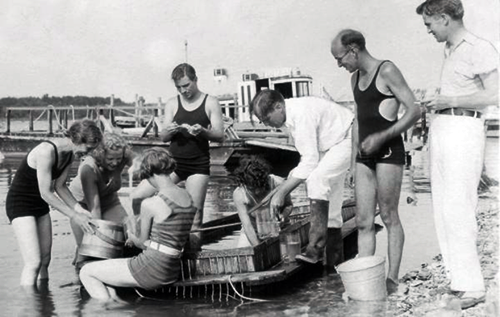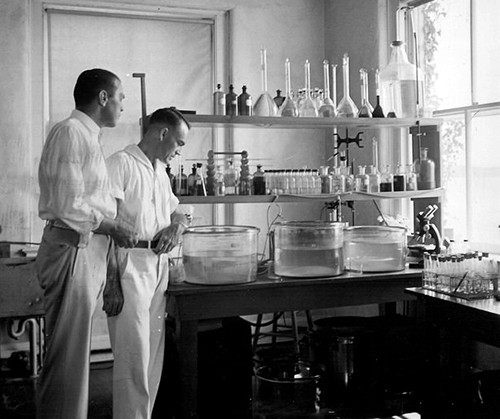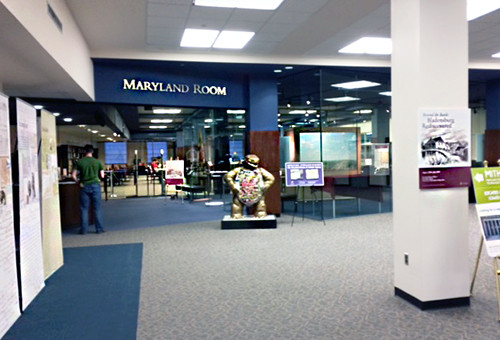Reginald V. Truitt in his own words: A visit to the Maryland Room archives
Bill Dennison ·Celebrating 90 years of UMCES series
Reginald V. Truitt (1890-1991) was the founder of Chesapeake Biological Laboratory in 1925, the forerunner of the University of Maryland Center for Environmental Science (UMCES). As part of the 90th anniversary of UMCES, I have been learning about Reginald Truitt and made a visit to the Maryland Room in Hornbake Library to peruse his archived papers. The papers were typewritten letters to various people and provided insights into Truitt's motivation and struggles to create and build a world class research laboratory.

I think that most succinct summary of his perspective on research in support of environmental management was the following: "The problems of conservation in Maryland are vast and need of study, explanation and policy formulation based on knowledge." (Letter to Curley Byrd, 1 July 1940). He also expressed his frustration that the University of Maryland did not share this perspective with the following: "Conservation and fisheries work are and have been my life's major interest and I have a deep seated feeling that the University in this matter in not meeting, again, in fact, an obligation it owes to the people of the State, current and future, thus this frank statement and appraisal." (Letter to Nevin Baker, 6 June 1949).
You can begin to appreciate the uphill battle that Truitt had in creating the first state marine laboratory in the country by the following passage: "The struggle to establish the laboratory and a program of research was hard and slow of development. I gave the name (C.B.L.) to the seat of my work in 1925. . .
. . . fired by ambition to establish a well based conservation program, I carried the financial burden largely by myself until the early 1930s." (Letter to Ernest Cory, July 3, 1972).

Truitt's upstanding character is on display with the following letter to the President of the University of Maryland, W.H. Elkins: "Dear Dr. Elkins, Please accept my most cordial thanks and deep appreciation of the action of the Board of Regents in selecting me to receive the Regents Distinguished Service award . . . In view of the hopes and plans cited, and as yet undeveloped, I would ask that someone else be selected this year instead of me to receive the award in question, despite the high honor involved. I should like to have at least one more year in which to attempt further to measure up to the award connotation . . . " (13 October 1961).
As Michael Fincham recounted in his Chesapeake Quarterly article "The Man Who Loved Lacrosse: Reginald V. Truitt & the Chesapeake Biological Lab", Truitt had a tempestuous relationship with H. "Curley" Byrd, President of the University of Maryland (1936-1954). I was able to witness this relationship directly in several letters. In a letter from Byrd to Truitt, the following was written by Byrd: "Dear Reg, Thank you very much for your letter of July 14 with enclosure. Unless something happens, I will come down to Solomons Island one day next week and spend the afternoon with you, and discuss at such length as may seem desirable the matters in which we have mutual interest with reference to the Chesapeake Bay. Best personal regards. Sincerely, H.C. Byrd, President" (17 July 1943). Truitt's hand written note in the margin of the letter was simply "He didn't come."

And then when Truitt attempted to meet with Byrd, he was repeatedly stood up: "This was in 1942. I was given an appointment by him four times which I kept but he didn't. On the fourth one he met me at the door, he being in conference, and said "Reg, you come in here this time tomorrow and I'll see you come hell or high water, not even Franklin Roosevelt will stop me, nothing short of the Master himself." I kept the appointment and found that he was in Baltimore. I tendered my resignation forthwith for, as I remarked to his secretary, I saw no unusual indication of divine presence." (Letter to Ernest Cory, July 3, 1972).
And the most blunt and pointed comments were made at the time that Byrd was making his unsuccessful bid for Governor of Maryland: "I am compelled to feel that looseness with the spoken word characterizes Professor Byrd to the point of intellectual schizophrenia which results in redoubling his efforts for office as he more and more obscures his objective." (Letter to the Baltimore Sun, October 29, 1954).
My favorite letter was the description of the creation of the iconic diamondback terrapin as the University of Maryland mascot. Truitt wrote the following: ". . .testudo was modeled by the Chesapeake's celebrated Diamondback Terrapin. . . This is in no small part was due to the fact that no animal in Maryland was more noted and the further fact that Maryland's celebrated cuisine provided no dish so distinct and supreme as terrapin ala Maryland."
In the 1920's, Maryland teams were still called the Aggies. The Old Line was used but not accepted even though it represented courage, bravery and sacrifice by our troops in the battle of Long Island.

Back in the late 1920's, young Bob Crain, sitting with a group at Bill White's emporium for breakfast, poo-hooed the idea of Old Line since at the time "line" meant something akin meant something brave talk, put on and even braggadocio. . . Bob proposed Terrapin as in keeping with Tiger, Wolfpack, Badger, Bulldog, Buckeye and all. It was a natural. The director of athletics, Byrd, came into the restaurant at the time and the subject was broached to him. A Crisfielder, (terrapin industrial center) he thought Bob's idea was good.
"As a member of the Zoology Department, I was asked to supply the biological data, which I did." (Letter to George Weber, May 3, 1973).
I am grateful that these papers have been preserved to gain some insight into this fascinating man. Included in the papers were Truitt's recommended curricula for fisheries and conservation programs, three by five cards with dance steps for the "Proms" which Truitt supervised, company drills for military exercises, evaluations of Zoology Department personnel and letters to Chesapeake Biological Laboratory sponsors. We feel privileged to be working at an organization founded by such an impressive scientist.
About the author
Bill Dennison

Dr. Bill Dennison is a Professor of Marine Science and Interim President at the University of Maryland Center for Environmental Science (UMCES).